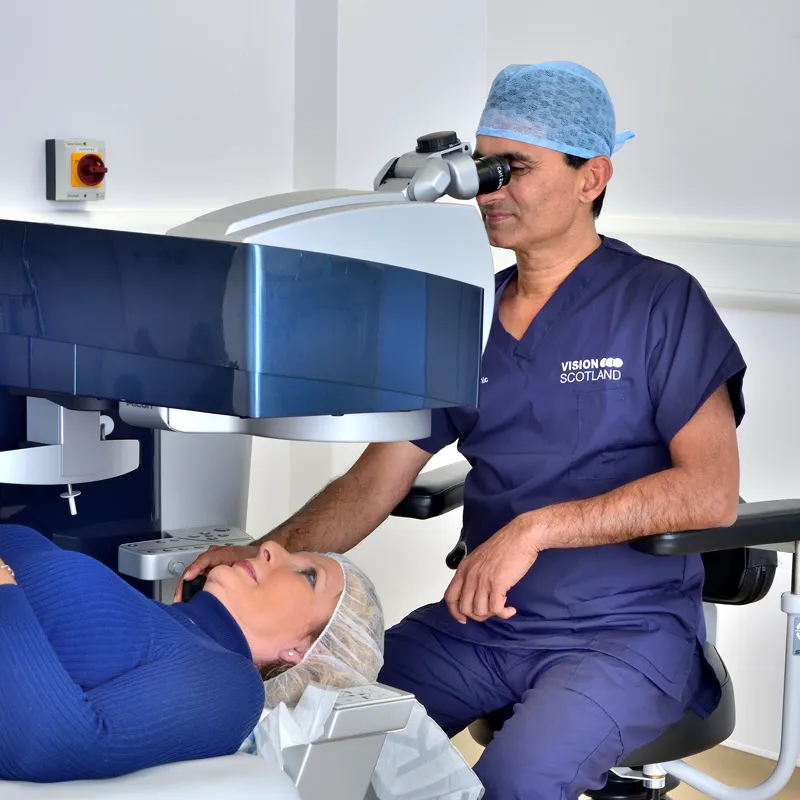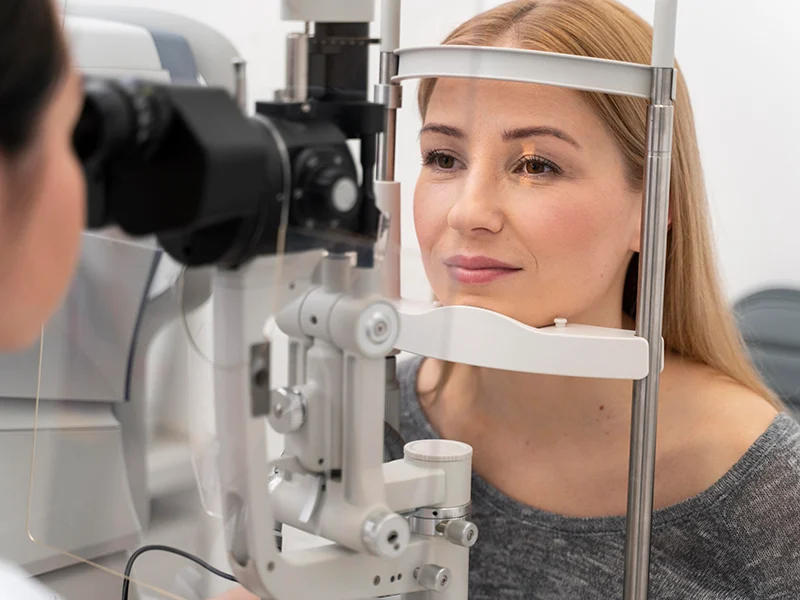Illness rarely occurs without warning and the eyes problems are no exception. Most eye conditions present with tell-tale symptoms which can give you vital clues about a diagnosis and treatment. We’ve collected the most common symptoms and signs that your eyes may need attention. It’s important to know that some of the most serious eye conditions don’t typically cause pain or sight impairment in their early stages, and as the eyes can compensate for each other, it often takes the condition to advance for someone to know something is wrong.
If you have any concerns about your vision, it’s important to seek early advice from your local optometrist.
The lens never lies
When a photo is taken with a flash camera, the flash reflects off the retina (the red reflex) and can produce tell-tale signs of eye disease. The red reflex is the effect of the flash lighting up the blood-rich retina. If this occurs evenly in both eyes then it is likely that there is no cause for concern, but if the light reflection affects each eye differently, you should consider further exploration.

Known as an “abnormal red reflex”, a reflection that is a white, yellow or black may a warning sign that something isn’t quite right.
Consultant surgeon Mr Mantry said “if you’re concerned about a reflection in a photo, it might be worth taking another one. Make sure conditions are optimal for identifying an abnormal red reflex. Make sure you are looking directly at the camera; the room should be dimly lit and the flash on. If you have red eye reduction camera settings, make sure they’re disabled”.
The most common reason for an abnormal red reflex is refractive error. This often occurs if the shape of your eye causes light to refract imperfectly. Therefore, you are more likely to suffer from white eye reflection if you suffer from myopia (short sight), hyperopia (log sightedness) or astigmatism. These conditions do not need to be treated but can be rectified with glasses or vision correction surgery.
On rare occasions, abnormal red reflexes can signal more serious eye conditions.
When only one eye reflex appears red, or the red reflex in each eye differs in intensity, , this may be an indicator of strabismus. Strabismus is a misalignment of the eyes, causing the eyes to out ‘out of sync’ with each other – not looking at the same place at the same time. Various orthoptic treatments are available including prisms, patching, blurring the strong eye and eye muscle surgery. Treated early, strabismus can be corrected with excellent results.
A white reflex covering most, or all of the pupil is an indicator of several eye disorders. The most common condition is cataracts (you often notice this same appearance in elderly dog as they are rarely treated for cataracts). It can rarely be a red flag for retinal detachments, infections in the eye and retinoblastoma. All have excellent recovery rates if identified and treated early.
A yellow reflex can be a sign of Coats’ disease. This is when blood vessels inside the eye become twisted and leaky. The dysfunction creates a blockage in the retina that can cause vision loss, glaucoma or retinal detachment. This condition is most commonly seen in young children. Again, if caught early, treatments such as laser surgery or cryotherapy can help.
Red Eyes
Probably the most obvious sign that there is something wrong with the eye is redness. This generic symptom can be caused by several conditions or trauma. It is typically caused when the eyes’ blood vessels become inflamed, making the white part of the eyeball appear pink or red.
Red eyes can be an indication that your eyes are irritated by conditions such as conjunctivitis, allergy, blepharitis and uveitis. It can also be a sign of something more serious such as scleritis. If symptoms persist or worsen over time, you should seek advice from your optometrist.
Difficulty seeing at night
There are two main causes of night vision problems. The first is when the eye struggles to adjust effectively between well-lit and dark environments, such as nystagmus – a neurological condition that causes the eye to involuntarily move even when the head is still . The second are conditions where the eye is unable to absorb enough light to see images clearly such as cataracts – where the lens becomes opaque and unable to absorb light – and retinitis pigmentosa – which causes a breakdown of the light sensitive tissue at the back of the eye.
Headache
While the most common causes of headaches are dehydration, stress and high blood pressure, they can also be a sign that there is a problem with the eyes. Most people know someone who has discovered they need glasses because they are suffering from headaches while looking at a screen or a black board. This would typically be identified by a dull generalised ache.
Sharp pains or throbbing temples that can’t be resolved with over-the-counter pain killers shouldn’t be ignored. If the pain is persisting for a long time, you should consult your doctor or optometrist.
There are various eye conditions associated with headaches. Migraines and photokeratitis can cause severe, prolonged pain often for several days. Angle-closure glaucoma which blocks the drainage canals in the eye, results in a sudden rise in pressure and is a medical emergency
Light Sensitivity
Light sensitivity (or photophobia) causes bright light to be uncomfortable, leading most sufferers to cover their eye frequently or wear sun glasses. Many people suffer from mild photophobia which is no cause for concern, in fact it is a protective feature of sight to prevent you from looking at lights that are bright enough to cause damage. For more severe sufferers, even normal day light can cause significant pain. Light sensitivity is often seen in those with cataracts, corneal abrasion, keratoconus and migraines.
Floaters
Floaters are small flecks, specs dots or lines that appear to be moving around on the surface of the eye. In fact, they are not in front of your eye at all. They are actually in the clear gel of the eye, between the lens and the retina – known as the vitreous. The floaters feel like they are on the surface as you see their shadows cast on the retina.
Although annoying, they are harmless in small quantities and usually disappear over time. Larger, more severe floaters however are worth attention as they are often a sign of conditions such as a retinal tear or detachment, eye lymphoma, diabetic retinopathy and uveitis.
Flashes
Flashes are bright spots or points of light in your field of vision. Similar to the effect of rubbing your eyes too hard or ‘seeing stars’ when hit on the head. You can develop flashes for several reasons but the most common cause is when the vitreous (the gel between the lens and the retina) shrinks and begins to pull on the retina. Unless you understand the cause for ‘flashes’ it should be investigated immediately in case it has been caused by a detached or torn retina. Always consult your optometrist.
Dry Eyes
Dry eye is caused when the eye doesn’t produce enough good quality tears to keep the eyes sufficiently lubricated, or when the eyes dry out too quickly for the tears to sufficiently keep up with production. The common tell-tale signs of dry eye are a feeling of grittiness, scratchiness or irritation. It is a chronic complaint for many but can also be a sign of blepharitis and Bell’s Palsy.
Excessive tearing
There are two main causes of excessive tearing. The first is that the eyes are producing too many tears. This is a natural response to inflammation, irritation and infection. The eyes use tears to flush the eye out and keep it clean. Irritated eyes produce tears to lubricate and soothe the eyes. There are conditions though where the eye works against its best interests producing more tears than are needed. Conditions such as bacterial keratitis, conjunctivitis, dry eye and allergy.
Another cause of excessive tearing is a blocked tear duct. Tear ducts carry tears away, preventing a build-up on the eye surface. If the duct is blocked, the tears cannot drain normally. This can happen as a result of an infection in the tear duct or an injury.
The above article describes a collection of symptoms that commonly occur for the conditions listed above. This article should not be used to diagnose eye conditions. If you’re experiencing changes in your ocular health or vision, it is important to visit your optometrist as soon as possible.




